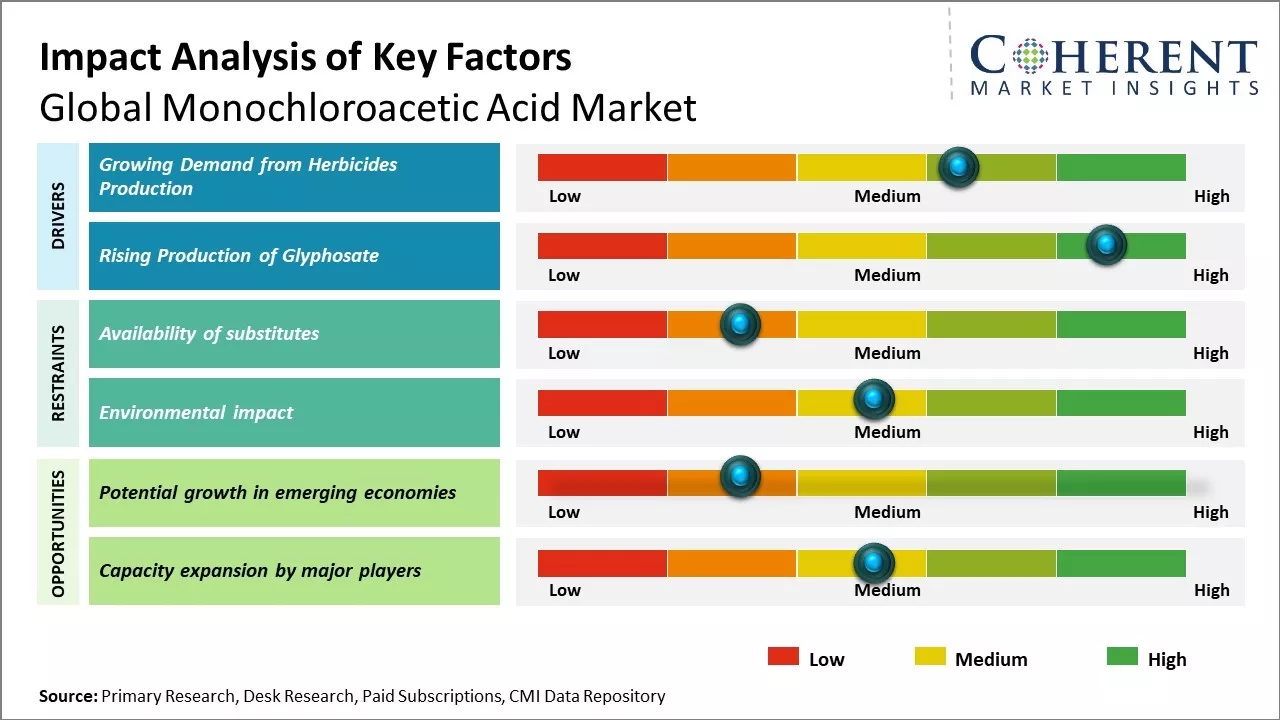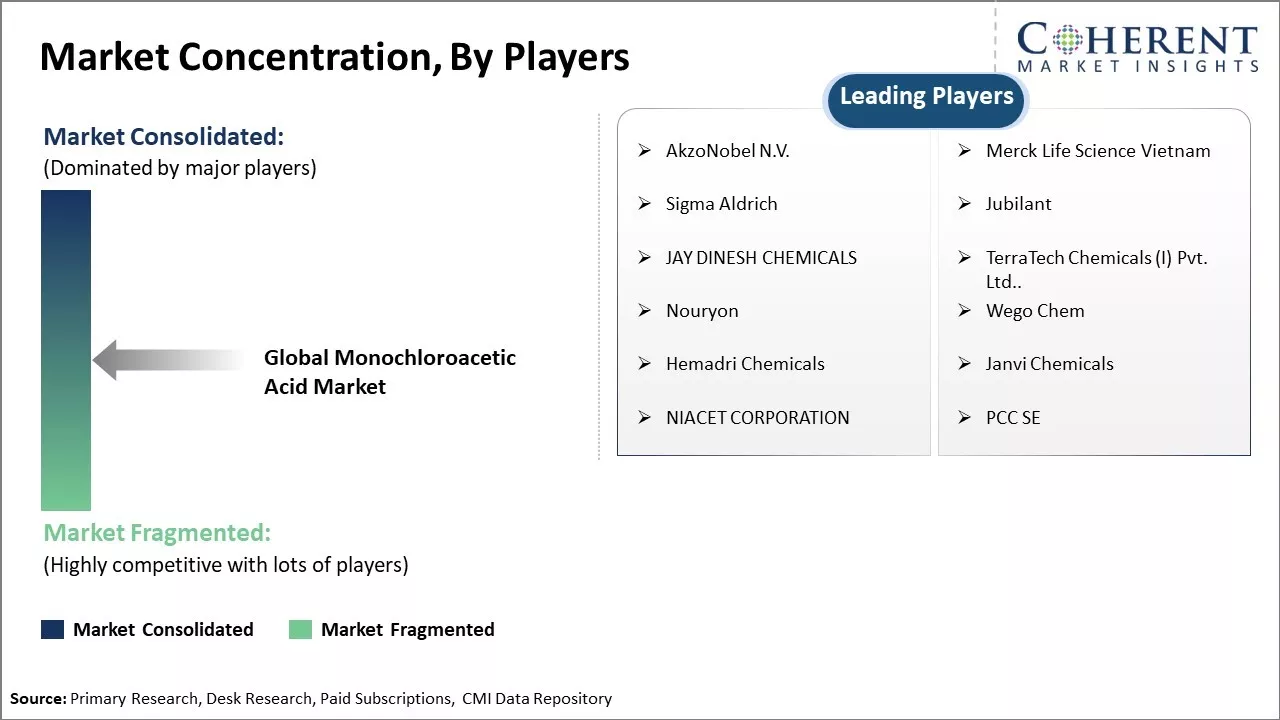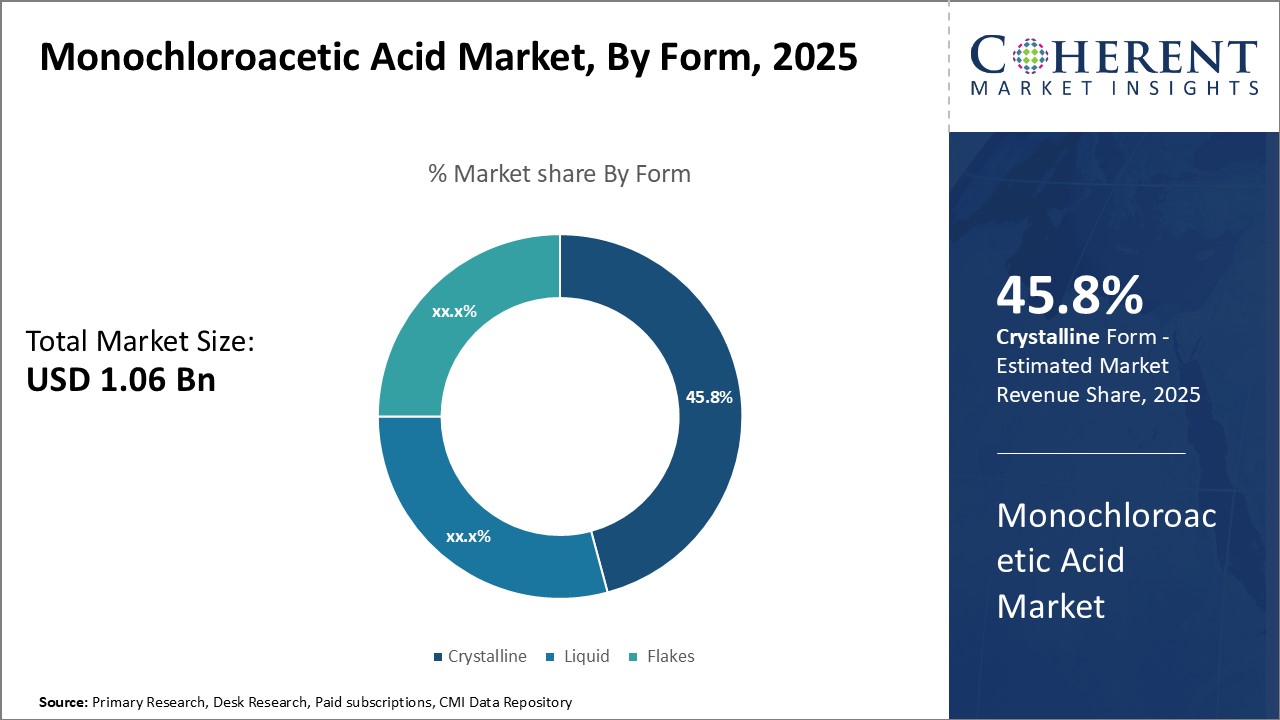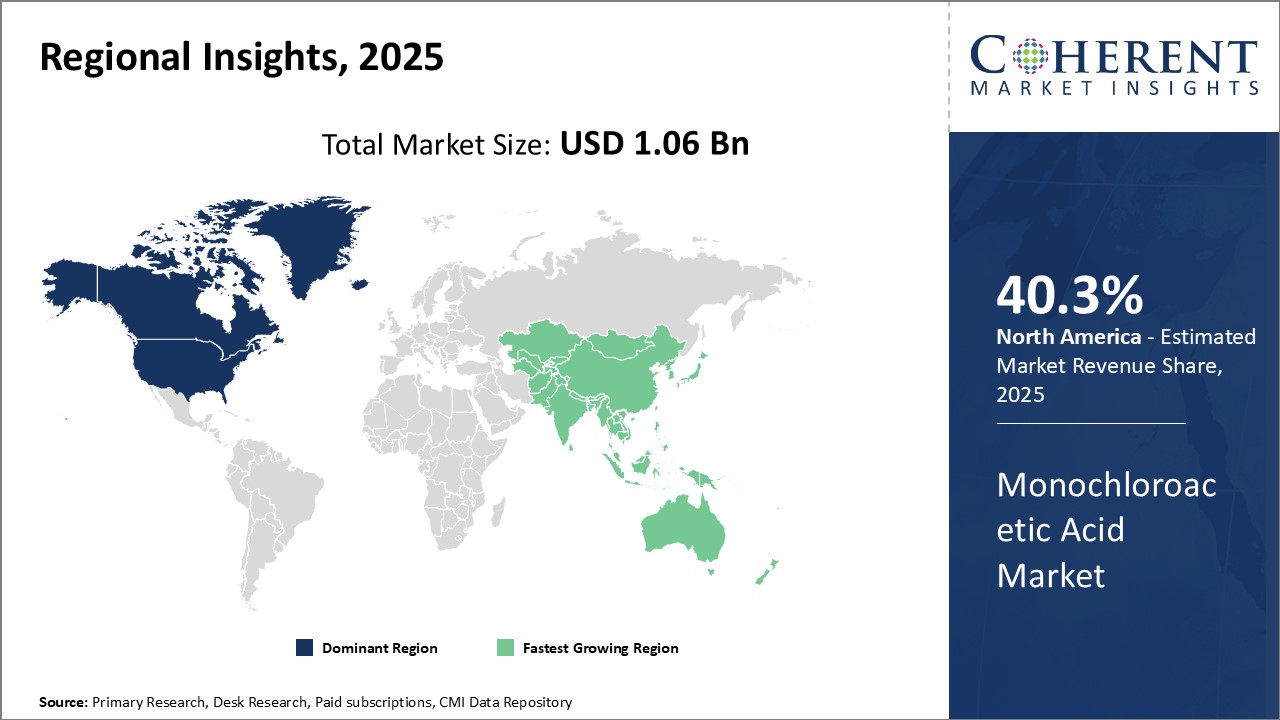The monochloroacetic acid market is estimated to be valued at USD 1.06 Bn in 2025 and is expected to reach USD 1.43 Bn by 2032, exhibiting a compound annual growth rate (CAGR) of 4.4% from 2025 to 2032.

Discover market dynamics shaping the industry: Download Free Sample
The global monochloroacetic acid market is expected to witness moderate growth over the forecast period. Monochloroacetic acid finds numerous application scope in industries such as plant growth regulators, drugs and pharmaceuticals, microbial control, water treatment, and others. The thriving agrochemical industry along with the increasing emphasis on water treatment across developing economies is expected to drive the demand for monochloroacetic acid in the coming years. Moreover, the growing need for effective drugs and medicines is also projected to augment the market growth during the analysis timeframe. However, strict regulations over the use of agrochemicals owing to environmental concerns may hamper the market expansion to some extent over the next few years. Nonetheless, continuous research and development activities for new applications are likely to pave new growth opportunities for the monochloroacetic acid market in the long run.
Growing Demand from Herbicides Production
The monochloroacetic acid market is expected to witness significant growth in demand driven primarily by its increasing usage in the production of herbicides. As a key intermediate ingredient, MCA finds wide applications in the manufacturing of several pre-emergent and post-emergent herbicides that are used extensively across various crops like cereals and grains, fruits and vegetables, and others. The global herbicide market has been growing steadily over the past few years and herbicides have become an integral part of several agricultural practices to maximize crop yields.
With the rising global population and growing demand for food, more agricultural land is being cultivated worldwide which has also increased the dependency on agricultural chemicals. Herbicides play a crucial role in weed management and allow cultivating higher yields from the same land parcel. This has significantly driven its consumption. Moreover, concerns regarding farm sustainability and decreasing arable land have further prompted growers to adopt improved weed control measures to protect crop yield from weed competition. The increasing need to boost productivity and meet the escalating food demand particularly in developing economies in Asia Pacific and Latin America are important factors bolstering the sales of herbicides.

Get actionable strategies to beat competition: Download Free Sample
Rising Production of Glyphosate
Glyphosate is the most widely used active ingredient in herbicide formulations worldwide and its production relies heavily on MCA as a key raw material. Glyphosate-based herbicides account for the largest share in the global herbicide market and are amongst the top-selling agricultural chemicals. The increased GM crop adoption coupled with the introduction of glyphosate-resistant crop varieties have further expanded the glyphosate market size over the years. According to various reports, glyphosate herbicide sales have grown at an impressive rate of 7-8% annually over the past decade.
With most key patents on glyphosate expiring, more manufacturers are keen on developing generic formulations. This has resulted in amplified production volumes to cater to the growing demands as well as increased accessibility of cost-effective glyphosate products. All such factors are contributing to the raised consumption of MCA predominantly utilized as a key intermediate in glyphosate synthesis. Expanding glyphosate production remains a major driver propelling the monochloroacetic acid market growth in the forthcoming years.
Key Takeaways from Analyst:
The monochloroacetic acid market is expected to grow steadily over the next five years. One of the key drivers for growth will be driving demand from the herbicide industry. As food production needs to increase globally to support rising population levels, the use of herbicides will also increase which will boost themonochloroacetic acid consumption.
Monochloroacetic acid finds widespread application in the production of carboxymethyl cellulose which is used for sizing and finishing of textiles. Rapid growth of the textile industry in Asia Pacific countries is likely to augment the monochloroacetic acid demand.
Strict environmental regulations regarding monochloroacetic acid production and disposal pose a noteworthy challenge to market players. As monochloroacetic acid is considered a hazardous chemical, it must be produced and handled following strict EHS guidelines. This increases production costs for manufacturers. Substitute products such as dichloroacetic acid may also limit the market's growth trajectory over the forecast period.
Market Challenges: Availability of substitutes
The availability of substitutes is significantly restraining the growth of the global monochloroacetic acid market. Monochloroacetic acid is predominantly used for the production of carboxyl methyl cellulose (CMC) which is an important chemical for many end-use industries. However, other cellulose ether derivatives such as hydroxyethyl cellulose (HEC) and hydroxypropyl cellulose (HPC) are emerging as viable substitutes for CMC. Both HEC and HPC offer similar properties as CMC including thickening, binding, and emulsifying abilities. Additionally, they have better stability over a wider pH range as compared to CMC. Many end-use industries are inclined towards replacing CMC with HEC and HPC in their formulations due to their superior chemical properties. For instance, the paper industry which is a key end-user of CMC is substituting nearly 10% of CMC with HEC and HPC annually according to estimates from the FAO. This is negatively impacting the demand for monochloroacetic acid which is predominantly consumed for CMC production. The availability of close substitutes is likely to restrain the monochloroacetic acid market growth in the coming years.
Market Opportunities: Potential growth in emerging economies
The emerging economies across Asia, Africa and South America showcase tremendous potential for growth in the global monochloroacetic acid market. With rising disposable incomes and robust economic expansion, demand for consumer goods, textiles, and other end-use applications is surging in these developing regions. According to data from the World Bank, the GDP growth rates of several developing nations such as India, Indonesia and Vietnam exceeded 5% annually during the period of 2020 to 2022. Rapid industrialization and infrastructure development alongside a huge young population are driving consumption as well as manufacturing activity. Since monochloroacetic acid is a widely used intermediate in the production of detergents, drugs, dyes and Crop Protection chemicals, its consumption is expected to climb significantly alongside economic progress in emerging territories.

Discover high revenue pocket segments and roadmap to it: Download Free Sample
Insights by Form: Ease of Handling
In terms of form, crystalline is expected to contribute 45.8% of the market share in 2025. The crystalline segment dominates due to its advantages in handling and storage. Crystalline MCA is preferred by many end-use industries as it is easier to handle and does not require specialized equipment for transportation. Its solid crystalline structure makes it safer to handle during manufacturing processes compared to flakes or liquid forms that could leak or spill. The crystallized form also allows for more precise dosing and mixing of MCA during production. Whether used directly as a reagent or as a feedstock to make other derivatives, accurate dosing is important for quality control and product consistency. The defined crystalline structure facilitates superior volume and weight measurement compared to other forms. This ease of handling reduces costs associated with improper dosing and wasted materials. Storage and inventory management is also simpler with crystalline MCA. As a solid, it takes up less space than liquids in tanks and drums. Less specialized temperature-controlled storage is needed compared to liquid storage. This makes crystalline MCA well-suited for stockpiling and just-in-time inventory models. Its durability and stability during storage extends shelf life with no risk of degradation over months like liquid MCA may experience. Overall, the crystallized form removes many health, safety, transportation and inventory handling challenges presented by other MCA forms. Though processing crystalline MCA into end products requires an initial dissolution step, manufacturers prefer to deal with beginning and intermediate solid materials when possible. This preference contributes to the crystalline segment maintaining its dominant position within the overall MCA market segmented by form.
Insights by Application: In terms Carboxymethylcellulose (CMC), Applications Drive the Highest Demand
Among the application segment of the monochloroacetic acid market, Carboxymethylcellulose (CMC) is expected to contribute the largest share of 42.9% in 2025. As a key derivative of MCA, CMC experiences growing demand driven by its use in a wide variety of consumer and industrial end products. CMC acts as a stabilizer, thickener, and binding agent in many applications. In the food industry, CMC increases viscosity and improves texture in sauces, dressings, and processed meats without altering taste or color. It also promotes water retention in baked goods. Syrups and beverages containing CMC pour and flow smoothly with a silky mouthfeel. These attributes make CMC ubiquitous as a food additive. Personal care products heavily rely on CMC for its film-forming and stabilizing functions in creams, lotions, and makeup. It prevents the separation of oil and water components in emulsions. CMC is also commonly used as a disintegrating agent in pharmaceutical tablets to aid dissolution. Beyond consumer goods, CMC exhibits thickening and suspension abilities valuable for industrial uses like ceramics, paints, paper coatings, and mining extraction operations. As environmental regulations tighten, CMC helps meet standards as a replacement for polluting viscosity modifiers. With such a wide breadth of useful qualities and growing adoption across multiple high-volume industries, the CMC applications segment will remain the largest driver of the overall MCA demand in the foreseeable future. This stabilization of dominant market share reinforces CMC’s importance in MCA production.

Need a Different Region or Segment? Download Free Sample
North America has established itself as the dominant region in the global monochloroacetic acid market. The region is expected to account for over 40.3% of the market share in 2025 due to a strong base of end-use industries such as herbicides, pharmaceuticals, and consumer goods in the U.S. Major players have invested heavily in setting up production plants catering to the regional requirement. Moreover, technical expertise and focus on innovation have enabled the region to continuously improve production processes and convert the co-products obtained to valuable derivatives, providing integrated solutions to clients.
However, the Asia Pacific region has emerged as the fastest growing market in recent years. Countries like China and India are witnessing a booming demand from the agrochemical, personal care and polymer industries. This can be attributed to the growing population, rising disposable incomes, and changing lifestyles. Domestic manufacturers are continually enhancing capacities of existing plants and commissioning new facilities to leverage the enormous untapped potential.
Monochloroacetic Acid Market Report Coverage
| Report Coverage | Details | ||
|---|---|---|---|
| Base Year: | 2024 | Market Size in 2025: | USD 1.06 Bn |
| Historical Data for: | 2020 To 2024 | Forecast Period: | 2025 To 2032 |
| Forecast Period 2025 to 2032 CAGR: | 4.4% | 2032 Value Projection: | USD 1.43 Bn |
| Geographies covered: |
|
||
| Segments covered: |
|
||
| Companies covered: |
AkzoNobel N.V., Merck Life Science Vietnam, Sigma Aldrich, Jubilant, JAY DINESH CHEMICALS, TerraTech Chemicals (I) Pvt. Ltd.., Nouryon, Wego Chem, Hemadri Chemicals, Janvi Chemicals, NIACET CORPORATION, and PCC SE |
||
| Growth Drivers: |
|
||
| Restraints & Challenges: |
|
||
Uncover macros and micros vetted on 75+ parameters: Get instant access to report
Share
Share
About Author
Yash Doshi is a Senior Management Consultant. He has 12+ years of experience in conducting research and handling consulting projects across verticals in APAC, EMEA, and the Americas.
He brings strong acumen in helping chemical companies navigate complex challenges and identify growth opportunities. He has deep expertise across the chemicals value chain, including commodity, specialty and fine chemicals, plastics and polymers, and petrochemicals. Yash is a sought-after speaker at industry conferences and contributes to various publications on topics related commodity, specialty and fine chemicals, plastics and polymers, and petrochemicals.
Missing comfort of reading report in your local language? Find your preferred language :
Transform your Strategy with Exclusive Trending Reports :
Frequently Asked Questions
Joining thousands of companies around the world committed to making the Excellent Business Solutions.
View All Our Clients